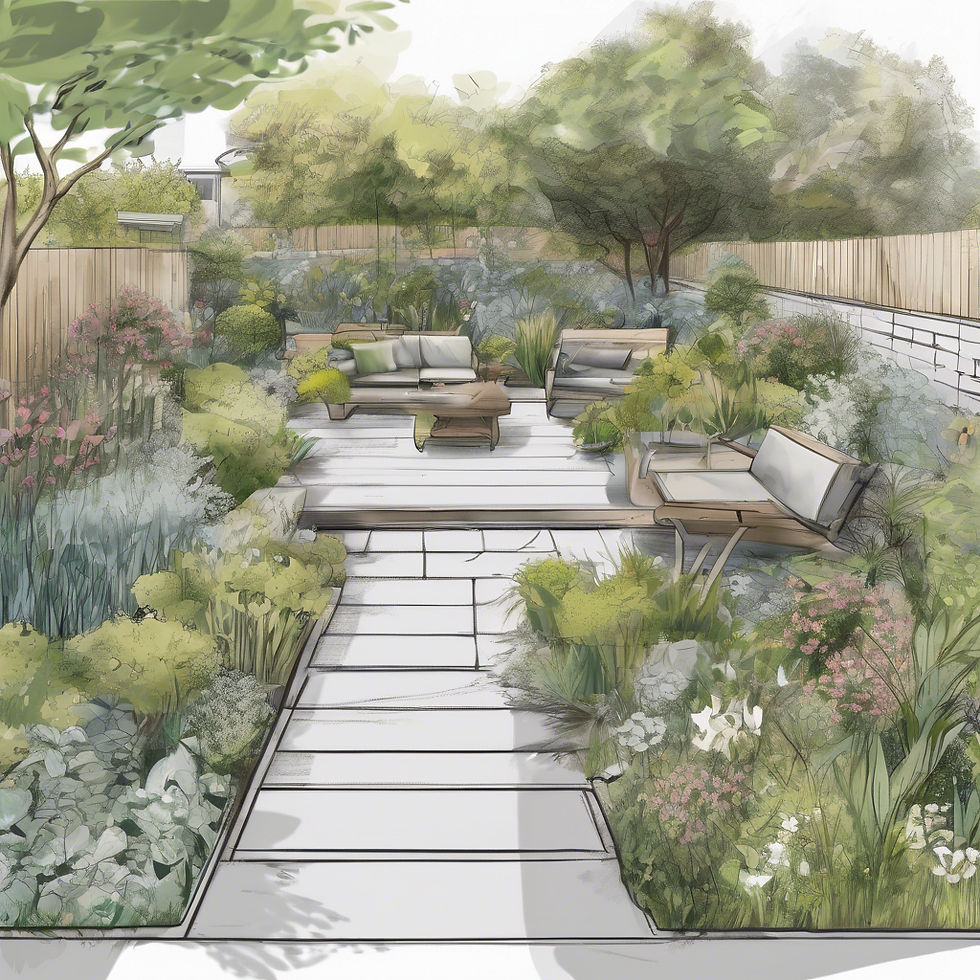How to Use Green Walls to Add Vertical Interest and Enclosure to Your Garden
- gpgardendesign
- Jul 7
- 4 min read
Updated: Jul 20
Transform Your Space with Green Walls: A Comprehensive Guide
Green walls - also known as living walls or vertical gardens - are an innovative way to bring nature upwards. They are especially useful when space is limited. Whether you’re working with a small courtyard, a shady corner, or want to soften a boundary fence, green walls can transform dull vertical surfaces into vibrant living features. In this post, we’ll explore how to design and install a green wall in your garden, what plants to use, and how to keep it thriving. We will also discuss using climbing plants as a more budget-friendly option that will still look great.
What is a Green Wall?
A green wall is a structure that allows plants to grow vertically. This can occur against an existing wall or on a freestanding frame. Unlike climbing plants that rely on supports, green walls utilize a modular or layered system to hold soil and water for vertically arranged plantings. These walls can serve ornamental or functional purposes. They provide insulation, shade, biodiversity, and enhance the beauty of your space.
Where Can You Install a Green Wall?
Green walls can be surprisingly versatile. Here are some applications in your garden:
Against fences or blank walls: Ideal for softening brick or concrete.
On balconies or patios: Perfect for those with limited floor space.
As privacy screens: Using a freestanding frame can enhance privacy.
In outdoor kitchens: Delight in growing herbs and edibles.
To divide garden zones: Use a green “room divider” to create distinct spaces.
Design and Installation Process
1. Choose Your Wall or Frame
Begin by selecting a vertical surface that receives the appropriate level of sunlight for your intended plants. South- or west-facing walls are ideal for sun-loving species, while shaded spots will necessitate shade-tolerant plants.
Your options include:
Brick or rendered walls (ensure they have waterproof backing)
Timber fences
Metal trellis frames or steel mesh panels
Custom freestanding green wall panels
2. Select a Green Wall System
Three main types of green wall systems are available:
Modular panels or trays: These pre-made kits come with planting pockets. They are easy to install and excellent for structured patterns.
Pocket planters: Fabric or felt systems hang like organizers. They are lightweight and suitable for small walls or herbs.
DIY containers on trellis: Mount pots, boxes, or recycled containers to a frame. This is a cost-effective and flexible option but demands more manual watering and maintenance.
3. Set Up Irrigation and Drainage
Healthy green walls need regular, even watering. Consider the following options:
Install a drip irrigation system with a timer for low-maintenance care.
Create a reservoir base to collect runoff and reduce waste.
Use self-watering containers or capillary matting for smaller setups.
Redirect building runoff drain pipes into the green wall, but remember they will still require watering in dryer seasons.
Ensure excess water drains freely, especially if mounting the wall close to your home.
Choosing the Right Plants
Your plant choices should reflect the light levels, microclimate, and wall size. Think about texture, color, and seasonal variation.
Best Plants for Green Walls:
For Sun:
Sedum and succulents
Lavender, thyme, oregano
Strawberry plants
Trailing pelargoniums
Creeping rosemary
For Shade:
Ferns (such as polypodium, maidenhair)
Heuchera
Ivy (variegated for added interest)
Lamium (dead nettle)
Hostas (for larger modules)
For Year-Round Interest:
Mix evergreen plants with flowering perennials or seasonal annuals.
Incorporate variegated foliage to brighten shady spots.
Design Tips
Layer textures and heights: Combine trailing plants with upright growers to create depth.
Use repetition: Repeating certain plants fosters a cohesive look.
Add color blocks or patterns: This is particularly effective with succulents or herbs.
Consider fragrance: Place scented herbs near seating areas for a more inviting space.
Frame it like art: Treat the green wall as a living picture, especially in smaller spaces.
Maintenance Tips
Water regularly: Automated systems assist, especially during the summer.
Feed plants monthly: Use a liquid feed suited to the plant types for optimal growth.
Trim and tidy: Prune dead foliage, remove spent flowers, and replant if necessary.
Check for pests: Dense plantings can attract aphids or slugs—inspect them regularly.
Green Wall Inspiration
Get inspired by these creative ideas:
A culinary herb wall near your BBQ or outdoor kitchen.
A fern tapestry installed on a shaded courtyard wall.
A succulent mural with geometric trays.
A pollinator-friendly wall showcasing flowering natives and nectar-rich plants.
A children’s sensory wall featuring fragrant, fuzzy, and edible leaves.
Closing Thoughts
Green walls represent more than just a creative use of space; they symbolize creativity and ecological care. Whether you want to soften a hard surface, grow more in a compact plot, or simply bring life to eye level, green walls can significantly transform your garden's feel.
Begin small with a pocket panel of herbs or go big with a full modular wall. The key is to design with your environment and lifestyle in mind.
If a full green wall system seems overwhelming, don't fret. Climbing plants can be a fantastic budget-friendly alternative. Using a simple trellis or tension wire system, climbers like clematis, star jasmine, ivy, or honeysuckle can provide vertical greenery, color, and even fragrance. While these plants may take longer to establish, they offer an affordable way to enhance your space, provide privacy, and attract wildlife. With them, you can prove that a big visual impact doesn’t require an elaborate setup.
_edited.png)





Comments